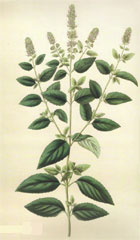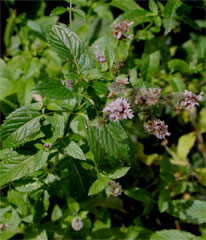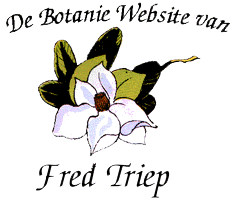|
|
||
This article has originally been published in the “Hortus Magazine” of December 2015
by Fred Triep
|
Toothpaste, chewing gum, candy, tea, in many everyday
products we use, peppermint has been incorporated. Also butterflies are pleased with the peppermint plant. But beware of cramps and palpitations! |
|
Peppermint, who does not know it?
We eat it like candy, use peppermint leaves in dishes and tea, mint is often
used in cosmetics and perfume.
Peppermint is made from peppermint oil
that is extracted from the leaves of the peppermint plant. The peppermint plant
(Mentha x piperita) is a cross between water mint (Mentha aquatica) and
spearmint (Mentha spicata). The seed of this plant shows little
germination, which suggests that the parent species are almost separate species.
Because of the bad seed, the plant can only be propagated by growing new plants
from rhizomes. A similar example in the animal world, where speciation is nearly
complete, we find at the horse and the donkey: they cross
with each other, giving the mule and the hinny, but these hybrids have no
descendants.
The genus Mint (Mentha) is found in Europe, Asia, Africa, Australia and North America and is almost cosmopolitan (subkosmopolitisch). Most mint species are present in a humid environment.
Left:
A historical sketch of a
peppermint plant

Click on the thumbnails if you want to see the large picture
Right: A peppermint plant from a city garden in
Dordrecht
Photo's: Fred Triep

Crossings
Because of the transitions between the various forms, it is
difficult to specify the exact number of species in the genus mint. Researchers
distinguish thirteen to eighteen species, some of which easily hybridizes in
nature.
There are in addition to the peppermint plant
more hybrids of mint species known. The false apple mint
(Mentha x rotundifolia) is a cross of horse mint
(Mentha longifolia) with apple mint (Mentha
suaveolens). In addition, there is the whorled mint
(Mentha x verticillata), a hybrid of M. aquatica and M.
arvensis and ginger mint or slender mint (Mentha
x gentilis), a cross between M. arvensis and M. spicata.
The genus Mentha is
a genus
of the
mint family
(Lamiaceae), a cosmopolitan plant family. The plants of this family are
characterized by two-sided symmetrical flowers, consisting of an upper lip and a
lower lip. The upper lip and the lower lip are the result of intergrowth of the
five petals. Also the sepals are fused. The leaves are opposite to each other
along the stems, which are often square in shape. At the mint species the color
of the flower is white to purple.
Many plants from this family possess
aromatic substances, which are used as a spice by humans: basil, mint, rosemary,
marjoram, oregano, hyssop, thyme and lavender.
The
mint species possess fragrant substance as menthol, which ends up in the
peppermint oil after extraction of the leaves and stems. Peppermint oil is
obtained by steam distillation: the mint leaves are done in boilers with water,
in which steam is blown. The oil, which release from the leaves, is carried
along with the water vapor. After cooling, the oil, which floats on the water,
is separated from the watery substance.
Peppermint oil
contains menthol, menthone, neomenthol and isomenthol which menthol is the main
constituent. Menthol is a monoterpene, an organic compound that would help our
body to expel bacteria and viruses. Monoterpenes are volatile liquids, which are
responsible for many plants fragrant flowers or leaves. The peppermint oil is
used for the production of sweets, tea and toothpaste.
The leaves of the mint are pressed into oil, but also used fresh
or dried in food. This gives a fresh sweet taste to the food, with a cool
aftertaste. Mint is widely used in the cuisine of the Middle East, as in lamb
dishes. In Anglo-Saxon countries mint is used in mint sauce and mint jelly. In
addition, mint is used in tea (including the Touareg or Moroccan tea from North
African countries) and alcoholic beverages such as mint julep, mojito, liqueur
creme de menthe and the cocktail grasshopper.
Allergic reaction
Peppermint oil and
menthol are also used as "seasoning" at mouth rinses, toothpaste, chewing gum,
desserts and chocolate mint. Peppermint as a candy contains, in addition to the
peppermint oil also sugar, gelatin and gum arabic. Mint is also used as a
traditional medicinal herb, among others against stomach and headaches. Menthol
and peppermint oil are used in the production of cosmetics and perfumes.
Some people may be allergic to products of the mint. This is
expressed in intestinal cramps, diarrhea, headache or heart palpitations.
Menthol and of the other terpenes oxidize easily in the skin, and the oxidation
products are probably the cause of the complaints.
Mint plants are important for certain butterflies as host plant. The
caterpillars, for example, of the pale yellow buff ermine (Spilarctia luteum), a
moth that occurs from Turkey to China, live on the mint plant.
In the Botanical Garden of Amsterdam (Hortus) you will find besides the peppermint plant also the water mint (Mentha aquatica), which grows in the dune fen among other dune plants.
Literatuur
C.
Kalkman
Planten voor dagelijks gebruik- Botanische
achtergronden en toepassingen
KNNV
Angiosperm Phylogeny Group
www.mobot.org/MOBOT/research/APweb/
Mentha- Wikipedia
en.wikipedia.org/wiki/Mentha
Pepermuntolie – Wikipedia
http://nl.wikipedia.org/wiki/Pepermuntolie
Menthol – Wikipedia
nl.wikipedia.org/wiki/Menthol
Pepermunt (snoep)
nl.wikipedia.org/wiki/pepermunt_snoep
This page has been
created on
Tuesday 6 September 2016.
![]()
Voor aanvullingen of reacties, stuur mij een email:
